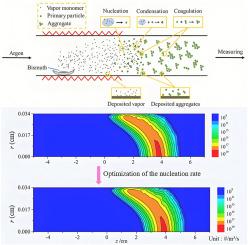铋族平衡均匀成核模型的参数辨识
IF 4.3
2区 材料科学
Q2 ENGINEERING, CHEMICAL
引用次数: 0
摘要
对铋蒸气均形核的多元种群平衡模型进行了验证。然而,一些关键参数的微小差异可能导致表面张力等不适定问题。在本研究中,根据响应面法设置的参数波动被用于种群平衡模拟,以确定其重要性。然后建立二次多项式代替模拟,用粒子演化特征参数评价波动。结果表明,表面张力是决定颗粒演化的最重要因素,同时还受凝结速率系数和混凝过程分形维数的影响。为了获得更精确的建模和关键参数,根据所有波动计算综合均方误差和,表面张力的适宜值为0.466 N/m。本文章由计算机程序翻译,如有差异,请以英文原文为准。

Parameter identification in the bismuth homogeneous nucleation model for population balance
A new multivariate population balance modeling for the homogenous nucleation from bismuth vapor is tested against experimental results. However, the small differences of some key parameters could lead to the ill-posed problem, such as the surface tension. In this study, the parameter fluctuations set according to the response surface method are employed in the population balance simulation to identify their importance. Subsequently, the quadratic polynomials are established to replace the simulation and the fluctuations are evaluated with the characteristic parameters of particle evolution. It is found that the surface tension tends to be the most significant factor determining the particle evolution, which is also influenced by the coefficient in condensation rates and fractal dimension in the coagulation. To get more accurate modeling and key parameters, the comprehensive sum of mean square error is calculated based on all the fluctuations and the appropriate value for the surface tension is 0.466 N/m.
求助全文
通过发布文献求助,成功后即可免费获取论文全文。
去求助
来源期刊

Particuology
工程技术-材料科学:综合
CiteScore
6.70
自引率
2.90%
发文量
1730
审稿时长
32 days
期刊介绍:
The word ‘particuology’ was coined to parallel the discipline for the science and technology of particles.
Particuology is an interdisciplinary journal that publishes frontier research articles and critical reviews on the discovery, formulation and engineering of particulate materials, processes and systems. It especially welcomes contributions utilising advanced theoretical, modelling and measurement methods to enable the discovery and creation of new particulate materials, and the manufacturing of functional particulate-based products, such as sensors.
Papers are handled by Thematic Editors who oversee contributions from specific subject fields. These fields are classified into: Particle Synthesis and Modification; Particle Characterization and Measurement; Granular Systems and Bulk Solids Technology; Fluidization and Particle-Fluid Systems; Aerosols; and Applications of Particle Technology.
Key topics concerning the creation and processing of particulates include:
-Modelling and simulation of particle formation, collective behaviour of particles and systems for particle production over a broad spectrum of length scales
-Mining of experimental data for particle synthesis and surface properties to facilitate the creation of new materials and processes
-Particle design and preparation including controlled response and sensing functionalities in formation, delivery systems and biological systems, etc.
-Experimental and computational methods for visualization and analysis of particulate system.
These topics are broadly relevant to the production of materials, pharmaceuticals and food, and to the conversion of energy resources to fuels and protection of the environment.
 求助内容:
求助内容: 应助结果提醒方式:
应助结果提醒方式:


